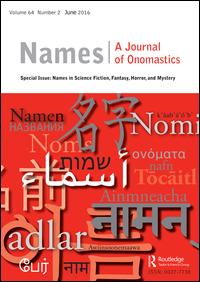Published 2014-09-01
Copyright (c) 2014 Maney Publishing

This work is licensed under a Creative Commons Attribution 4.0 International License.
Abstract
AbstractEach prison yard is a microcosm of society: a community with its own culture and hierarchy. Prison nicknames are a matter of social negotiation, a common everyday phenomenon with a multiplex nature. One of the authors of this article is currently serving a sentence and has supplied examples based on his own observations and informal interviews with other inmates who were willing to give him information they would not usually confide to outsiders. Knowing and using nicknames (1) gives a sense of unity among prison peers, while (2) representing their individuality, and (3) facilitating communication among them. Nicknames can be friendly, showing peer approval and in-group unity. They can also be cruel and vicious. Nicknames can be bestowed due to appearance, personality, preferences, background, or experience. They are also used for in-group communication about hidden activities or identities.
References
- Adams, Michael.2009. “Power, Politeness, and the Pragmatics of Nicknames.” Names 57(2): 81–91.
- Bernstein, Basil.1964. “Elaborated and Restricted Codes: Their Social Origins and Some Consequences.”American Anthropologist 66: 55–69.
- Crozier, W. Ray and Patricia S. Dimmock. 1999. “Name-calling and Nicknames in a Sample of Primary School Children.” British Journal of Educational Psychology 69(4): 427–625.
- de Klerk, Vivian and Barbara Bosch. 1996. “Nicknames as Sex-Role Stereotypes.” Sex Roles 35(9–10): 525–541.
- Hale, Christopher S.1981. “Modern Icelandic Personal Bynames.”Scandinavian Studies 53: 115–146.
- Holland, Theodore J.1990a. “The Many Faces of Nicknames.” Names 38(4): 225–272.
- Holland, Theodore J.1990b. “The Nicknames of Steam-Era Railroaders: A Code-Mediated Adaptation.” Names 38(4): 295–304.
- Jackson, Bruce.1967. “Prison Nicknames.” Western Folklore 26(1): 48–54.
- Leslie, Paul L. and Skipper, James K. Jr. 1990. “Toward a Theory of Nicknames: A Case for Socio-Onomastics.” Names 38(4): 273–282.
- Maurer, David W. and Allan W. Futrell. 1981. “Criminal Monikers.” American Speech 57(4): 243–255.
- Mehrabian, Albert.2001. “Characteristics Attributed to Individuals on the Basis of Their First Names.” Genetic, Social & General Psychology Monographs 127(1): 59–88.
- Mencken, H. L.1919. The American Language. New York, NY: Knopf.
- Mook, Maurice A.1967. “Nicknames Among the Amish.”Names 15: 111–118.
- Skipper, James K., Jr. 1985. “Nicknames of Notorious American Twentieth Century Deviants: The Decline of the Folk Hero Syndrome.”Deviant Behavior 6: 99–114.
- Skipper, James K., Jr. 1990. “Placenames Used as Nicknames: A Study of Major League Baseball Players.” Names 38(1 & 2): 1–13.
- Skipper, James K., Jr and Leslie, paul L.1990. “The Systematic Study of Personal Nicknames: A Small Step Forward.” Names 38(4): 253–254.
- Starks, Donna, Leech Kerry-Taylor, and 2012 Louisa Willoughby.. “Nicknames in Australian Secondary Schools: Insights into Nicknames and Adolescent Views of Self.” Names 60(3): 135–149.

